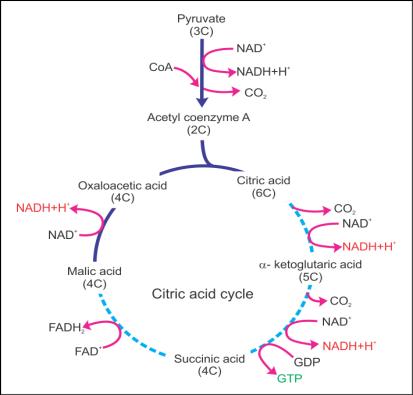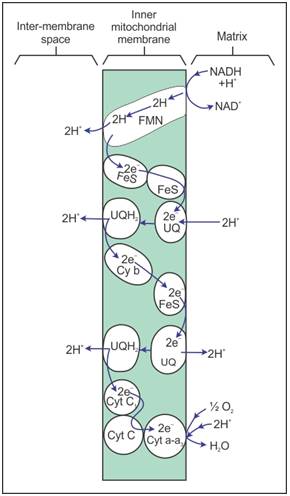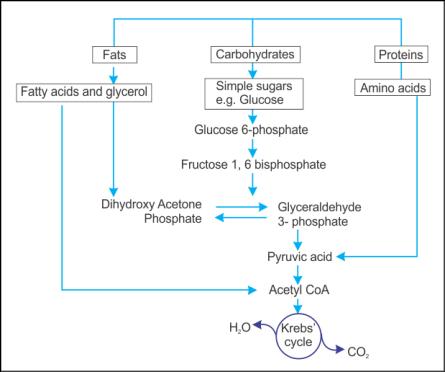Q1. The Krebs cycle occurs in
Solution
The Krebs cycle occurs inside the matrix of
mitochondria.
Q2. Name the final
hydrogen acceptor in the electron transport system.
Solution
Oxygen
Q3. The fermentation products of
yeast are
Solution
Yeast cells undergo alcoholic fermentation in
which glucose is first converted to pyruvic acid. It
is again converted to acetaldehyde. Alcohol dehydrogenase changes it to ethyl
alcohol and CO2.
Q4. Write the chemical equations for the Krebs cycle.
Solution

Q5. State the
components of complex IV.
Solution
Cytochrome a,
cytochrome a3 and two copper centres are the components of complex
IV.
Q6. The overall goal of
glycolysis, Krebs cycle and the electron transport system is the formation of
Solution
Glycolysis, Krebs cycle and electron transport
system are meant for ATP synthesis in different steps.
Q7. The end products of aerobic
respiration are
Solution
Aerobic respiration is an enzyme-mediated energy
liberating catabolic process which involves the step-wise oxidative breakdown
of organic substrate into CO2 and water
with oxygen acting as a terminal oxidant.
Q8. The respiratory quotient (RQ) for fatty acid is
Solution
In fats, a large amount of O2 is used to combine with H2, so the output of CO2 is less and RQ is only 0.70.
Q9. Name the structures in plants responsible for gaseous exchange.
Solution
Stomata and lenticels
Q10. The apparatus to measure the rate
of respiration and RQ is
Solution
A respirometer is an
instrument used to measure the rate of respiration and the respiratory
quotient.
Q11. Oxidative phosphorylation
involves simultaneous oxidation and phosphorylation to finally form
Solution
Oxidative phosphorylation is the process in which
ATP is formed as the electrons are transferred from NADH or FADH2 to O2 by a series of electron carriers, located in the
inner membrane of the mitochondria.
Q12. When fats
are the respiratory substrate, the value of RQ would be
Solution
When fats are the respiratory substrates, they are
hydrolysed to glycerol and fatty acids. The complete oxidation of glycerol
yields an RQ of approx. 0.86. As fatty acids are deficient in O2,
they require more O2 for oxidation as compared to CO2.
Therefore, O2 absorption is more and CO2 liberation is less,
and the RQ becomes less than 1.
Q13. The terminal cytochrome of the respiratory chain which donates
electrons to oxygen is
Solution
The respiratory assembly contains electron carriers
such as cytochromes. The correct sequence of electron carrier/acceptor in ATP
synthesis is cyt-b, cyt-c1, cyt-c, cyt-a and cyt-a3. Cyt-a3 is the terminal cytochrome
as it possesses two copper centres which help in the transfer of electrons to
oxygen.
Q14. The site of respiration in
bacteria is
Solution
The cytoplasmic membrane of bacteria invaginates into the cytoplasm at certain places in the
form of tubules called mesosomes. Enzymes found on their surfaces are
associated with respiration.
Q15. In which one of the following
do the two names refer to one and the same thing?
Solution
The tricarboxylic acid
cycle is also known as the citric acid cycle. This is an aerobic process which
takes place in the matrix of mitochondria. Because it was discovered by Krebs
in 1937, it is known as the Krebs cycle.
Q16. The site of glycolysis is
Solution
Glycolysis is a process in which glucose is broken
down to pyruvic acid without the help of an external
electron acceptor such as oxygen. It occurs in the cell cytoplasm.
Q17. Give the schematic representation of the TCA cycle.
Solution
TCA Cycle:


Q18. State the two steps in glycolysis where ATP is used.
Solution
Step 1:
When the glucose is phosphorylated into glucose-6-phosphate in the
presence of hexokinase, one molecule of ATP is used.
Step 2:
The second molecule of ATP is used when fructose-6-phosphate is
phosphorylated into fructose-1,6-bisphosphate.
Q19. Which of the following minerals activate the enzymes involved in
respiration?
Solution
Magnesium is absorbed in the form of magnesium ions (Mg2+).
It activates the enzymes of respiration and photosynthesis.
Manganese is absorbed in the form of manganous ions (Mn2+).
It activates many enzymes which are involved in photosynthesis, respiration
and nitrogen metabolism.
Q20. Respiratory Quotient (RQ) is
Solution

Q21. In the complete oxidation of
glucose, the greatest number of ATP molecules formed from ADP is during
Solution
In glycolysis, 2ATP and 2NADH2 molecules are formed. These 2 NADH2 molecules go
to the electron transport chain.
Q22. How are fats
utilised as substrates in aerobic respiration?
Solution
Fats are first
broken down into glycerol and fatty acids.
Fatty acids are
first degraded to acetyl CoA and then they enter the TCA cycle.
Glycerols are
converted into phosphoglyceraldehyde, and they can then enter the glycolytic
pathway.
Q23. The respiratory substrate
yielding the maximum number of ATP molecules is
Solution
A respiratory substrate yielding the maximum number
of ATP molecules is glucose. One glucose molecule on aerobic respiration
yields 36 ATP molecules.
Q24. The aerobic respiratory
pathway is appropriately termed
Solution
An amphibolic pathway is a biochemical pathway which
serves both anabolic and catabolic processes. Example: Krebs cycle involves
both catabolism of carbohydrates and synthesis of anabolic precursors for
amino acid synthesis.
Q25. The process common to both aerobic and anaerobic organisms is
Solution
Glycolysis is a process in which glucose is broken down to pyruvic acid without the help of an external electron acceptor such as oxygen. It occurs in the cell cytoplasm and so is common to both aerobic and anaerobic organisms.
Q26. Oxidative phosphorylation is the
production of
Solution
Oxidative phosphorylation is the synthesis of ATP
from ADP and inorganic phosphate which occurs with the help of energy
obtained from the oxidation of reduced coenzymes formed in cellular
respiration.
Q27. The maximum amount of
energy/ATP is liberated on oxidation of
Solution
Fats or lipids are a source of energy. By weight,
each gram mol of fat yields about 9.3 kcal of energy, i.e. more than double
of that yielded by glucose.
Q28. In the Krebs cycle, FAD
participates as an electron acceptor during the conversion of
Solution
During the oxidation of succinic acid to fumaric
acid, electrons and H+ ions are taken up by FAD, which gets reduced to FADH2.
Q29. The end product of Krebs
cycle is
Solution
The Krebs cycle begins by linking acetyl CoA to oxaloacetic acid forming
citric acid. In the presence of various enzymes, the cycle continues through
the formation of various intermediates and the release of CO2 and H2O as end-products.
Q30. The
end-product of oxidative phosphorylation is
Solution
The
aerobic breakdown of one glucose molecule yields 14 H2O and 36 ATP
molecules.
Q31. The chemiosmotic coupling
hypothesis of oxidative phosphorylation proposes that ATP is formed because
Solution
In 1961, Peter Mitchell put forward the chemiosmotic
hypothesis for ATP synthesis.
According to this, when electrons flow from a dual
proton, electron carrier to a non-hydrogen carrier, the H+ ions are released
and expelled into the intermembrane space and thus creates a proton gradient with
higher concentration of H+ in the intermembranous space than the matrix. Because
of proton motive force, the protons flow back and the energy liberated during
this backflow of protons activates ATPase present in the F1 head to synthesise ATP.
Q32. How would proteins enter the respiratory pathway?
Solution
Proteins are first degraded into amino acids by enzyme proteases.
The amino acids either enter the pathway immediately or first get degraded to pyruvate or acetyl CoA.
Q33. State the factor on
which the respiratory quotient depends.
Solution
The respiratory
quotient depends on the type of respiratory substrate used in respiration.
Q34. The
ultimate electron acceptor of respiration in aerobic organisms is
Solution
In aerobic organisms, the final electron acceptor of
respiration is oxygen. Molecular oxygen is a strong oxidising agent, and
therefore, an excellent electron acceptor.
Q35. Write the chemical equation of the complete combustion of glucose during respiration.
Solution

Q36. Name the enzymes which catalyse the incomplete oxidation of glucose in yeasts.
Solution
Pyruvic acid decarboxylase and alcohol dehydrogenase
Q37. All enzymes of the TCA cycle
are located in the mitochondrial matrix except one which is located in the inner
mitochondrial membrane in eukaryotes and in the cytosol in prokaryotes. This
enzyme is
Solution
Succinate dehydrogenase is present on the inner
membrane of mitochondria and catalyses the oxidation of succinate to
fumarate.
Q38. State the site where the oxidative decarboxylation of pyruvic acid
takes place.
Solution
Matrix of mitochondrion
Q39. In
the mitochondrial electron transport system, for every two pairs of electrons
which pass from NADH molecules through a sequential series of cytochrome
enzymes to molecular oxygen generate
Solution
In
mitochondrial electron transport system, for every single pair of electrons which
passes from NADH molecules through a sequential series of cytochrome enzymes
to molecular oxygen generates 3 ATP. So, two pairs of electrons would
generate a total of 6 ATP.
Q40. The connecting link between
glycolysis and the Krebs cycle is
Solution
In glycolysis, one molecule of glucose is broken
down to two molecules of pyruvic acid. Before entering the Krebs cycle, pyruvic acid is carboxylated oxidatively to produce acetyl CoA,
NADPH and CO2 with the help of the enzyme complex pyruvate
dehydrogenase. Here, acetyl CoA acts as a
connecting link between glycolysis, Krebs cycle and carbohydrate and fat
metabolism.
Q41. Of 38 ATP molecules produced
per glucose, 32 ATP molecules are formed from NADH/FADH2 in
Solution
Oxidative phosphorylation is the synthesis of energy-rich
ATP molecules with the help of energy liberated during the oxidation of
reduced coenzymes (NADH2 and FADH2) produced in
glycolysis and the Krebs cycle. A total of 10 NADH2 and 2FADH2 molecules are formed in aerobic respiration. They
help in the formation of 32 or 34 ATP molecules.
Q42. Protein is the respiratory
substrate in
Solution
Respiration which uses proteins as a substrate is
called protoplasmic respiration, whereas that which uses carbohydrates or
fats is termed floating respiration.
Q43. Write the chemical equation for the decarboxylation of pyruvic acid to acetyl CoA.
Solution

Q44. Name the component responsible for the
transfer of electrons between complex III and complex IV.
Solution
Cytochrome c
Q45. What are respiratory substances?
Solution
Substances which are oxidised during the process of respiration are
called respiratory substances.
Q46. State the site of glycolysis in the cell.
Solution
Cytoplasm
Q47. Describe the components of complex V in ETS. State their role in ATP synthesis.
Solution
Complex V of ETS consists of an F1 protein complex present on the peripheral membrane of mitochondria, and F0 is an integral membrane protein complex.
F0 forms the passage through which protons cross the inner membrane to bind to the catalytic site for the formation of ATP.
F1 provides the active site for the binding of protons during the synthesis of ATP.
Q48. Name the reaction during which glucose-6-phosphate is formed from
glucose.
Solution
Phosphorylation
Q49. Name the component which transfers electrons from ubiquinol to cytochrome c.
Solution
Cytochrome bc1 or complex III transfers electrons from ubiquinol to cytochrome c.
Q50. Name the two products formed by two successive decarboxylations in the
TCA cycle.
Solution
α-ketoglutaric acid and succinyl CoA
Q51. In which form do the
proteins enter the respiration pathway?
Solution
Acetyl CoA
Q52. The respiratory pathway
is any amphibolic pathway. Justify.
Solution
To enter the
respiratory pathway, fatty acids and proteins are broken down or degraded to
acetyl CoA.
During the
synthesis of proteins and fats, the substances are withdrawn from the
respiratory pathways and used in anabolism.
The breakdown of
substances is called catabolism, and the formation of substances is called
anabolism. Because the respiratory pathway is responsible for both anabolism
and catabolism, it is called an amphibolic pathway.
Q53. Name the enzyme which catalyses the conversion of pyruvic acid to
acetyl CoA.
Solution
Pyruvic dehydrogenase
Q54. What do you understand by the term cellular respiration?
Solution
The term cellular respiration indicates the oxidation of certain
macromolecules and the breaking of C-C bonds present in these molecules in
the cells to release energy.
Q55. Name the enzyme which catalyses the conversion of sucrose into glucose
and fructose.
Solution
Invertase
Q56. State the two products formed during glycolysis by the splitting of fructose-1,6-bisphosphate. State the relationship between NADH + H+.
Solution
The splitting of fructose-1,6-bisphosphate during glycolysis forms glyceraldehydes-3-phosphate and dihydroxyacetone phosphate.
1 NADH + H+is equivalent to three molecules of ATP.
Q57. Where does the
electron transport system take place in the mitochondrion?
Solution
The electron
transport system takes place in the inner membrane of the mitochondrion.
Q58. Write the chemical equation for the use of fats in respiration. Also state the RQ of the reaction.
Solution

Q59. Explain ETS by giving its diagrammatic representation.
Solution
Diagrammatic representation of ETS:


Q60. State the two important events which occur during aerobic respiration.
Solution
Two events which occur during aerobic respiration are
Complete oxidation of pyruvate by the removal of all hydrogen atoms, releasing three molecules of CO2.
The electrons removed as part of hydrogen atoms are passed on to the molecular oxygen with simultaneous synthesis of ATP.
Q61. What is the first step of the TCA cycle?
Solution
The first step of the TCA cycle is the condensation of the acetyl group
of acetyl CoA with oxaloacetic acid and water to obtain citric acid.
Q62. Name the substance which is released during the formation of citric
acid in the TCA cycle.
Solution
CoA
Q63. Write the other
name of complex IV.
Solution
The other name of
complex IV is cytochrome c oxidase complex.
Q64. Differentiate between fermentation and glycolysis.
Solution
Fermentation
Glycolysis
It
occurs under anaerobic condition.
It
occurs during aerobic condition.
The
net gain of ATP is 3.
The
net gain of ATP is 8.
Q65. Name the isomer of glucose-6-phosphate formed during glycolysis.
Solution
Fructose-6-phosphate
Q66. What will be the RQ if tripalmitin is used as a substrate in respiration?
Solution
0.7
Q67. Give the schematic representation of the pathway for anaerobic
respiration.
Solution
Pathway of anaerobic respiration:


Q68. State the net gain
of ATPs by the oxidation of one glucose molecule.
Solution
38 ATP
Q69. Give the schematic representation of the EMP pathway (glycolysis).
Solution
EMP Pathway:


Q70. Draw a flowchart
explaining the interrelationship between the metabolic pathway and the breakdown
of different molecules into CO2 and H2O.
Solution

Q71. At a temperature above 35°C,
Solution
The optimum temperature for photosynthesis in C3 and
C4 plants is 10-25°C and 30-45°C, respectively. However, the optimum
temperature for respiration is 20-30°C which means that respiration has a
higher optimum temperature than photosynthesis which declines later.
Q72. What is respiratory quotient? State the formula used to calculate the respiratory quotient.
Solution
The respiratory quotient is the ratio of the volume of CO2 evolved to the volume of O2 consumed in respiration.
The formula used to calculate the respiratory quotient is


Q73. State the functions
of complex I and complex II in ETS.
Solution
Complex I oxidises
the electron produced by NADH during the TCA cycle.
Complex II helps in
the reduction in ubiquinone to ubiquinol.
Q74. State the net gain of ATP during glycolysis.
Solution
8 molecules of ATP
Q75. Name the pathway discovered by Gustav Embden, Otto Meyerhof and J.
Parnas.
Solution
Glycolysis or EMP pathway
Q76. How many molecules of NADH + H+ are formed from one
molecule of glucose?
Solution
Two molecules of NADH + H+are formed from one
molecule of glucose.
Q77. Draw a well-labelled diagram indicating the synthesis of ATP in mitochondria.
Solution
Synthesis of ATP in mitochondria:


Comments
Post a Comment